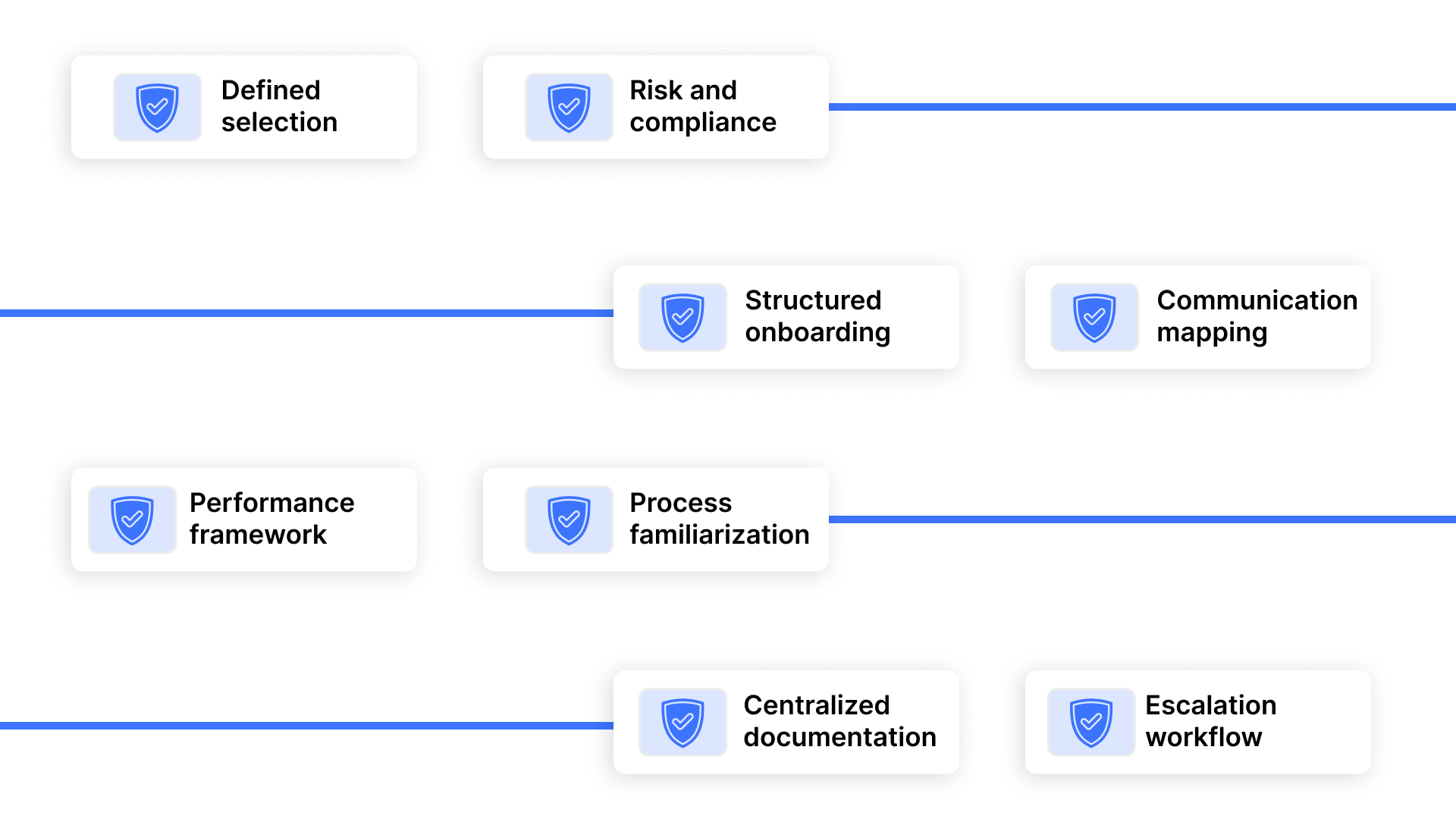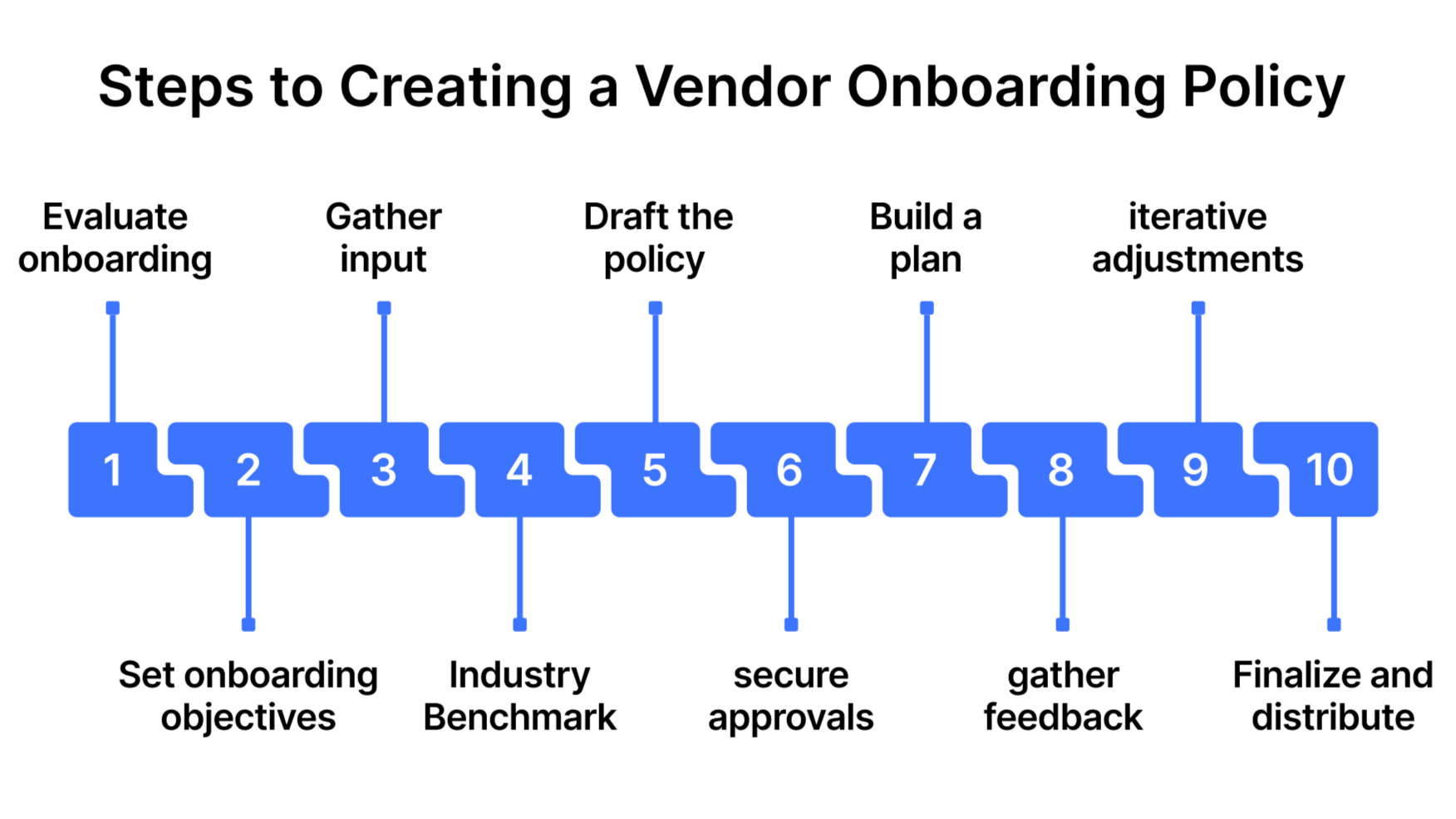How to Create an Effective Vendor Onboarding Packet
Establishing strong vendor relationships starts with a clear, structured onboarding process. If you're managing a few critical suppliers or overseeing a large, diverse vendor network, having the right documentation in place ensures consistency, compliance, and collaboration from day one.
A well-prepared vendor onboarding packet doesn’t just streamline the initial setup; it also protects your business from regulatory risks, improves procurement workflows, and sets the tone for long-term partnerships. From essential forms to policies and communication guidelines, vendor onboarding documents are the foundation for managing third-party relationships effectively.
This guide walks through everything you need to know about creating a robust vendor onboarding policy, including what to include, how to organize it, and how to ensure it's aligned with your company’s risk and compliance standards.
Overview
Vendor onboarding is the process of integrating new vendors into your systems through structured evaluation, compliance, and documentation.
A vendor onboarding policy standardizes this process, improves efficiency, and mitigates third-party risk.
Core components include due diligence forms, compliance checklists, communication protocols, and contract templates.
Clear documentation helps ensure faster approvals, smoother collaboration, and better long-term vendor relationships.
Platforms like Auditive’s Trust Center enable dynamic workflows, automate risk checks, and offer a centralized approach to vendor risk management.
What is Vendor Onboarding?
Vendor onboarding is the structured process of collecting essential information from new suppliers and equipping them with the knowledge they need to align with your organization’s operations. This step typically occurs before any purchase is made and serves as the foundation for a compliant and efficient partnership.
The process involves submitting required documentation, answering standard evaluation questions, and reviewing the company’s expectations around communication, compliance, invoicing, data handling, and service levels. It ensures vendors are clear on what’s expected and that your team has the necessary background to manage the relationship without delays or misalignment.
A solid onboarding approach reduces friction, builds mutual trust, and helps both parties get started with clarity and confidence.
Why Is Vendor Onboarding Important?
Vendor onboarding plays a key role in building reliable partnerships and reducing business risk. A structured process helps ensure vendors are compliant, aligned, and ready to deliver from day one.
It:
Strengthens relationships by showing professionalism and respect
Reduces legal, financial, and reputational risk through proper vetting
Streamlines collaboration by setting clear expectations and systems access
Improves quality by aligning vendors with performance standards
Attracts better vendors who value transparency and efficiency
In short, effective onboarding saves time, avoids friction, and lays the foundation for long-term vendor success.
Benefits of a Vendor Onboarding Policy
A clear vendor onboarding policy is more than a procedural necessity; it’s a foundational tool for managing external relationships with precision and accountability. When applied consistently, it improves how your organization interacts with suppliers and mitigates risks that could otherwise impact operations or compliance.
Here are some of the key benefits of implementing a structured vendor onboarding policy:
Standardization across teams
A unified onboarding policy ensures every department follows the same process, reducing inconsistencies and misunderstandings when engaging new vendors.
Operational efficiency
With documented workflows and predefined requirements, onboarding becomes faster and less error-prone. This reduces the administrative burden on procurement and legal teams.
Vendor risk management
By defining clear criteria for vetting suppliers, verifying credentials, and conducting due diligence, businesses can proactively reduce third-party risk. This includes compliance checks, security assessments, and financial reviews, critical components in managing vendor exposure effectively.
Performance alignment
A solid onboarding framework sets expectations for vendor deliverables, timelines, and communication protocols. This leads to more predictable performance and helps maintain service quality over time.
Scalable growth
As the business expands, a policy-driven approach allows teams to onboard more vendors without compromising standards or speed. It’s a foundation for sustainable procurement operations.
Continuous improvement
A policy encourages regular evaluation and optimization. By tracking what works and what doesn't, organizations can improve vendor engagement and refine onboarding strategies over time.
Auditive helps organizations take this further. Its centralized Trust Center and automated Vendor Risk Management workflows ensure every new vendor meets compliance, performance, and security standards, right from the onboarding stage. By digitizing risk scoring, documentation tracking, and ongoing monitoring, Auditive accelerates vendor onboarding while reducing operational and reputational risks.
Key Components of a Vendor Onboarding Policy
An effective vendor onboarding policy is built around clarity, accountability, and risk mitigation. While the structure may vary across industries, the foundational elements remain consistent. Here’s what a well-designed policy should include:
Defined selection and evaluation criteria
Set clear benchmarks for assessing potential vendors before engagement. This includes pricing, service quality, scalability, compliance history, reputation, and ability to meet operational or technical requirements. By establishing consistent standards upfront, organizations avoid subjective decisions and ensure vendor alignment from the start.
Risk and compliance protocols
Legal and regulatory obligations should never be an afterthought. Vendor onboarding must include due diligence checks, data privacy terms, required certifications, insurance verification, and contract clauses that reflect your industry’s compliance standards. Integrating this early helps prevent exposure to legal, reputational, or cybersecurity risks.
Structured onboarding process
Every step, from initial vetting to documentation and approval, should follow a standardized workflow. Outline exactly what vendors need to submit, how internal teams will review, and what systems or tools are involved. This reduces delays, ensures consistency, and creates a smoother experience for both sides.
Communication and responsibility mapping
Miscommunication is a common cause of onboarding delays. Define key internal and vendor-side contacts, escalation paths, documentation handoff processes, and turnaround expectations. This minimizes ambiguity and keeps the process on track.
Performance and accountability framework
Establish clear metrics for vendor success. Whether it’s delivery timelines, service uptime, product quality, or responsiveness, aligning vendors to measurable KPIs ensures accountability. Include guidelines for regular performance reviews and contract reassessments.
Training and process familiarization
Not all vendors operate within your systems or understand internal protocols. Include onboarding support such as tool access guides, operational playbooks, or Q&A sessions. This accelerates vendor ramp-up and avoids repeated clarification requests.
Centralized documentation and record-keeping
Maintain a single source of truth for all vendor-related files, contracts, risk assessments, contact logs, invoices, certifications, and compliance reviews. Centralization supports audit readiness and simplifies vendor oversight across departments.
Escalation and issue resolution workflow
Problems will arise, whether it’s a delay, data breach, or non-compliance. Your policy should document how such issues are reported, escalated, and resolved. Having this mapped out avoids reactive decision-making and ensures accountability.
A policy is only as good as its execution. To make these components actionable and sustainable, organizations need a system that connects onboarding, compliance, and vendor lifecycle management in one place.
This is where a platform like Auditive brings structure and visibility. With automated onboarding workflows, built-in risk assessment, and a centralized Trust Center, Auditive helps teams enforce policy standards while reducing manual oversight.
Step-by-Step Guide to Creating a Vendor Onboarding Policy
A well-structured vendor onboarding policy ensures consistency, reduces risk, and improves collaboration with third-party partners. Below is a practical step-by-step approach to building a policy that’s both actionable and aligned with compliance expectations.
Step 1: Evaluate current onboarding processes
Start by reviewing your existing onboarding protocols. Identify inefficiencies, bottlenecks, or missing controls. This initial audit helps define what needs to change and which capabilities your updated policy must include.
Step 2: Set clear onboarding objectives
Define what your onboarding policy is designed to accomplish. Common goals include reducing onboarding time, ensuring compliance with regulatory frameworks (e.g., ISO 27001, NIST CSF), or improving vendor tiering based on risk levels.
Step 3: Gather cross-functional input
Procurement, legal, IT security, and finance all bring essential perspectives. Align early with these stakeholders to ensure your policy meets their specific requirements, especially around risk mitigation and regulatory alignment.
Step 4: Benchmark against industry standards
Incorporate best practices tailored to your sector. A healthcare company’s vendor risk posture will differ from a financial services firm’s. Consider how similar organizations structure onboarding around critical compliance needs and third-party risk exposure.
Step 5: Draft the policy and checklist
Use all collected inputs to draft the onboarding policy. Your documentation should cover:
Vendor selection and qualification criteria
Onboarding procedures
Compliance documentation and due diligence
Risk assessment methods
Communication protocols
Ongoing monitoring and training
Documentation standards and retention
Escalation processes and exceptions
Review cadence
Support the policy with a standardized onboarding checklist to guide execution.
Step 6: Review, refine, and secure approvals
Circulate the draft across departments. Address concerns, refine the language, and verify that controls align with internal audit or regulatory expectations. Secure sign-off from legal, procurement leadership, and risk teams.
Step 7: Build an implementation plan
Establish timelines, training sessions, and internal communications to ensure the policy is adopted consistently. Each stakeholder must understand their responsibilities and how to apply the onboarding framework across vendors.
Step 8: Monitor rollout and gather feedback
Track how the policy performs in live scenarios.
Are compliance gaps closing?
Are vendors completing onboarding faster?
Use structured feedback from internal teams to measure success and uncover friction points.
Step 9: Make iterative adjustments
Incorporate insights from real-world applications. As regulations evolve or business needs shift, revise the onboarding policy accordingly. Treat it as a living document, not a one-time project.
Step 10: Finalize and distribute the policy
Once refined, roll out the approved policy organization-wide. Ensure it's easy to access, and define a clear path for proposing future updates. Maintain centralized documentation for audits, vendor reviews, or regulatory checks.
How Auditive Helps Streamline Vendor Onboarding Policies
Building a robust vendor onboarding policy is only part of the solution; executing it consistently across departments and evolving it based on live risk signals is where most organizations fall short. That’s where Auditive comes in.
Auditive provides a centralized Trust Center that aligns procurement, legal, compliance, and security teams around a shared view of vendor risk. With customizable workflows, Auditive simplifies onboarding documentation, automates compliance checks, and standardizes due diligence, reducing onboarding time and increasing operational efficiency.
Key advantages Auditive delivers in onboarding:
Automated risk reviews: Ingest questionnaires, SOC reports, and compliance evidence to automatically identify gaps and trigger review actions.
Unified vendor profiles: Consolidate key documents, assessments, contracts, and escalations in one place, streamlining communication and audit readiness.
Customizable onboarding workflows: Tailor onboarding steps based on vendor tier, business criticality, or data access levels.
Continuous monitoring: Go beyond point-in-time reviews with real-time alerts on vendor posture changes, helping you adapt onboarding policies dynamically.
For organizations looking to implement or refine their vendor onboarding documents and procedures, Auditive acts as the system of record and action, making vendor risk management smarter, faster, and fully auditable.
Conclusion
An effective vendor onboarding packet isn’t just paperwork; it’s your first step toward building trusted, resilient supplier relationships. When scaling partnerships or tightening regulatory compliance, well-documented policies make onboarding faster, cleaner, and more transparent.
Auditive elevates this process with a purpose-built Trust Center, enabling smarter vendor risk management from day one. By centralizing documentation, automating assessments, and enabling real-time collaboration across stakeholders, Auditive transforms onboarding into a strategic business asset.
Schedule a personalized demo with Auditive to see how you can simplify onboarding while strengthening third-party trust.
FAQs
Q1. What should a vendor onboarding packet include?
A1. It typically includes vendor forms, compliance checklists, security questionnaires, contract templates, onboarding steps, and points of contact.
Q2. Why is vendor onboarding documentation important?
A2. Clear documentation ensures legal compliance, faster procurement cycles, reduced risk exposure, and better coordination across departments.
Q3. How does vendor onboarding reduce risk?
A3. It allows you to assess a vendor’s financial, operational, and cybersecurity posture upfront, helping mitigate potential threats early.
Q4. Can onboarding documents be reused for multiple vendors?
A4. Yes, standardized templates can be reused and adapted based on vendor category or risk level.
Q5. How does Auditive support vendor onboarding?
A5. Auditive’s Trust Center automates due diligence, manages workflows, and maintains audit-ready records, accelerating onboarding while enforcing risk controls.






